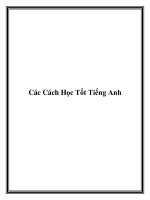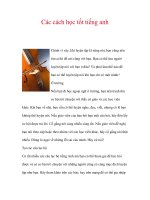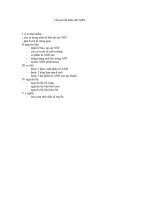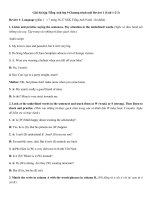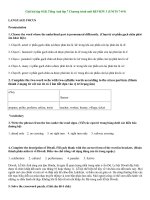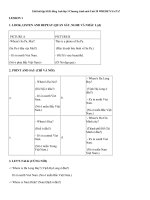Tiếng anh chuyên ngành kế toán part 4
Bạn đang xem bản rút gọn của tài liệu. Xem và tải ngay bản đầy đủ của tài liệu tại đây (120.22 KB, 10 trang )
18
Understanding the Numbers
• Cash Equivalents are near-cash securities such as U.S. Treasury bills ma-
turing in three months or less.
• Accounts Receivable are amounts owed by customers and should be re-
ported on the balance sheet at “realizable value,” which means “the
amount reasonably expected to be collected in cash.” Any accounts whose
collectibility is in doubt must be reduced to realizable value by deducting
an allowance for doubtful debts.
• Inventories in some cases may not be liquid in a crisis (except at fire-sale
prices). This condition is especially likely for goods of a perishable, sea-
sonal, high-fashion, or trendy nature or items subject to technological ob-
solescence, such as computers. Since inventory can readily lose value, it
must be reported on the balance sheet at the “lower of cost or market
value,” or what the inventory cost to acquire (including freight and insur-
ance), or the cost of replacement, or the expected selling price less costs
of sale—whichever is lowest.
Despite these requirements designed to report inventory at a realistic
amount, inventory is regarded as an asset subject to inherent liquidity
risk, especially in difficult economic times and especially for items that
are perishable, seasonal, high-fashion, trendy, or subject to obsolescence.
For these reasons the current ratio is often modified by excluding inven-
tory to get what is called the quick ratio or acid test ratio:
• In the case of Nutrivite, the quick ratio as of December 31 is $40,600/
$40,000, or 1. This indicates that Nutrivite has a barely adequate quick
ratio, with no margin of safety at all. It is a red flag or warning signal.
The current ratio and the quick ratio deal with all or most of the current
assets and current liabilities. There are also short-term liquidity ratios that
focus more narrowly on individual components of current assets and current li-
abilities. These are the turnover ratios, which consist of:
• Accounts Receivable Turnover.
• Inventory Turnover.
• Accounts Payable Turnover.
Turnover, which means “making liquid,” is a key factor in liquidity. Faster
turnover allows a company to do more business without increasing assets. In-
creased turnover means that less cash is tied up in assets, and that improves
liquidity. Moving to the other side of the balance sheet, slower turnover of lia-
bilities conserves cash and thereby increases liquidity. Or more simply, achiev-
ing better turnover of working capital can significantly improve liquidity.
Turnover ratios thus provide valuable information. The working capital
turnover ratios are described next.
Quick Ratio
Current Assets Inventory
Current Liabilities
=
−
Using Financial Statements
19
Accounts Receivable Turnover
The equation is:
So, if Credit Sales are $120,000 and Accounts Receivable are $30,000, then
On average, Accounts Receivable turn over 4 times a year, or every 91 days.
The 91-day turnover period is found by dividing a year, 365 days, by the
Accounts Receivable Turnover ratio of 4. This average of 91 days is how long it
takes to collect Accounts Receivable. That is fine if our credit terms call for
payment 90 days from invoice but not fine if credit terms are 60 days, and it is
alarming if credit terms are 30 days.
Accounts Receivable, unlike vintage wines or antiques, do not improve with
age. Accounts Receivable Turnover should be in line with credit terms; turnover
sliding out of line with credit terms signals increasing danger to liquidity.
Inventory Turnover
Inventory turnover is computed as follows:
If Cost of Goods Sold is $100,000 and Inventory is $20,000, then
or about 70 days. Note that the numerator for calculating Accounts Receivable
Turnover is Credit Sales but for Inventory Turnover is Cost of Goods Sold. The
reason is that both Accounts Receivable and Sales are measured in terms of the
selling price of the goods involved. That makes Accounts Receivable Turnover
a consistent ratio, where the numerator and denominator are both expressed at
selling prices in an “apples-to-apples” manner. Inventory Turnover is also an
“apples-to-apples” comparison in that both numerator, Cost of Goods Sold, and
denominator, Inventory, are expressed in terms of the cost, not the selling
price, of the goods.
In our example, the Inventory Turnover was 5, or about 70 days. Whether
this is good or bad depends on industry standards. Companies in the auto-
retailing or the furniture-manufacturing industry would accept this ratio. In
the supermarket business or in gasoline retailing, however, 5 would fall far
Inventory Turnover times a year==
$,
$,
100 000
20 000
5
Inventory Turnover
Cost of Goods Sold
Inventory
=
Accounts Receivable Turnover ==
$,
$,
120 000
30 000
4
Accounts Receivable Turnover
Credit Sales
Accounts Receivable
=
20
Understanding the Numbers
below their norm of about 25 times a year, or roughly every 2 weeks. As with
Accounts Receivable Turnover, an Inventory Turnover that is out of line is a
red flag.
Accounts Payable Turnover
This measure’s equation is:
If Cost of Goods Sold is $100,000 and Accounts Payable is $16,600, then
which is about 6, or around 60 days. Again, note the consistency of the numer-
ator and denominator, both stated at the cost of the goods purchased. Accounts
Payable Turnover is evaluated by comparison with industry norms. An Ac-
counts Payable Turnover that is appreciably faster than the industry norm is
fine, if liquidity is satisfactory, because prompt payments to suppliers usually
earn cash discounts, which in turn lower the Cost of Goods Sold and thus
lead to higher income. However, such faster-than-normal Accounts Payable
Turnover does diminish liquidity and is therefore unwise when liquidity is
tight. Accounts Payable Turnover that is slower than the industry norm en-
hances liquidity and is therefore wise when liquidity is tight but inadvisable
when liquidity is fine, because it sacrifices cash discounts from suppliers and
thus reduces income.
This concludes our survey of the ratios relating to short-term liquidity—
the current ratio; quick, or acid test, ratio; Accounts Receivable Turnover; In-
ventory Turnover; and Accounts Payable Turnover.
If these ratios are seriously deficient, our diagnosis may be complete. The
subject business may be almost defunct, and even desperate measures may be
insufficient to revive it. If these ratios are favorable, then short-term liquidity
does not appear to be a threat and the financial doctor should proceed to the
next set of tests, which measure long-term solvency.
It is worth noting, however, that there are some rare exceptions to these
guidelines. For example, large gas and electric utilities typically have current
ratios less than 1 and quick ratios less than 0.5. This is due to utilities’ excep-
tional characteristics:
• They usually require deposits before providing service to customers, and
they can shut off service to customers who do not pay on time. Customers
are reluctant to go without necessities such as gas and electricity and
therefore tend to pay their utility bills ahead of most other bills. These
factors sharply reduce the risk of uncollectible accounts receivable for
gas and electric utility companies.
Accounts Payable Turnover =
$,
$,
100 000
16 600
Accounts Payable Turnover
Cost of Goods Sold
Accounts Payable
=
Using Financial Statements
21
• Inventories of gas and electric utility companies are not subject to much
risk from changing fashion trends, deterioration, or obsolescence.
• Under regulation, gas and electric utility companies are stable, low-risk
businesses, largely free from competition and consistently profitable.
This reduced risk and increased predictability of gas and electric utility
companies make short-term liquidity and safety margins less crucial. In turn,
the ratios indicating short-term liquidity become less important, because short-
term survival is not a significant concern for these businesses.
LONG-TERM SOLVENCY
Long-term solvency focuses on a firm’s ability to pay the interest and principal
on its long-term debt. There are two commonly used ratios relating to servicing
long-term debt. One measures ability to pay interest, the other the ability to
repay the principal. The ratio for interest compares the amount of income
available for paying interest with the amount of the interest expense. This ratio
is called Interest Coverage or Times Interest Earned.
The amount of income available for paying interest is simply earnings be-
fore interest and before income taxes. (Business interest expense is deductible
for income tax purposes; therefore, income taxes are based on earnings after
interest, otherwise known as earnings before income taxes.) Earnings before
interest and taxes is known as EBIT. The ratio for Interest Coverage or Times
Interest Earned is EBIT/Interest Expense. For instance, assume that EBIT is
$120,000 and interest expense is $60,000. Then:
This shows that the business has EBIT sufficient to cover 2 times its inter-
est expense. The cushion, or margin of safety, is therefore quite substantial.
Whether a given interest coverage ratio is acceptable depends on the industry.
Different industries have different degrees of year-to-year fluctuations in
EBIT. Interest coverage of 2 times may be satisfactory for a steady and mature
firm in an industry with stable earnings, such as regulated gas and electricity
supply. However, when the same industry experiences the uncertain forces of
deregulation, earnings may become volatile, and interest coverage of 2 may
prove to be inadequate. In more-turbulent industries, such as movie studios and
Internet retailers, an interest coverage of 2 may be regarded as insufficient.
The long-term solvency ratio that reflects a firm’s ability to repay principal
on long-term debt is the “Debt to Equity” ratio. The long-term capital structure
of a firm is made up principally of two types of financing: (1) long-term debt and
(2) owner equity. Some hybrid forms of financing mix characteristics of debt
and equity but usually can be classified as mainly debt or equity in nature.
Therefore the distinction between debt and equity is normally clear.
Interest Coverage or Times Interest Earned ==
$,
$,
120 000
60 000
2
22
Understanding the Numbers
If long-term debt is $150,000 and equity is $300,000, then the debt-
equity relationship is usually measured as:
Long-term debt is frequently secured by liens on property and has prior-
ity on payment of periodic interest and repayment of principal. There is no pri-
ority for equity, however, for dividend payments or return of capital to owners.
Holders of long-term debt thus have a high degree of security in receiving full
and punctual payments of interest and principal. But, in good times or bad,
whether income is high or low, long-term creditors are entitled to receive no
more than these fixed amounts. They have reduced their risk of gain or loss in
exchange for more certainty. By contrast, owners of equity enjoy no such cer-
tainty. They are entitled to nothing except dividends, if declared, and, in the
case of bankruptcy, whatever funds might be left over after all obligations have
been paid. Theirs is a totally at-risk investment. They prosper in good times
and suffer in bad times. They accept these risks in the hope that in the long run
gains will substantially exceed losses.
From the firm’s point of view, long-term debt obligations are a burden
that must be carried whether income is low, absent, or even negative. But long-
term debt obligations are a blessing when income is lush since they receive no
more than their fixed payments, even if incomes soar. The greater the propor-
tion of long-term debt and smaller the proportion of equity in the capital struc-
ture, the more the incomes of the equity holders will fluctuate according to
how good or bad times are. The proportion of long-term debt to equity is
known as leverage. The greater the proportion of long-term debt to equity, the
more leveraged the firm is considered to be. The more leveraged the firm is,
the more equity holders prosper in good times and the worse they fare in bad
times. Because increased leverage leads to increased volatility of incomes, in-
creased leverage is regarded as an indicator of increased risk, though a moder-
ate degree of leverage is thus considered desirable. The debt-to-equity ratio is
evaluated according to industry standards and each industry’s customary
volatility of earnings. For example, a debt-to-equity ratio of 80% would be con-
sidered conservative in banking (where leverage is customarily above 80% and
earnings are relatively stable) but would be regarded as extremely risky for
toy manufacturing or designer apparel (where earnings are more volatile). The
well-known junk bonds are an example of long-term debt securities where
leverage is considered too high in relation to earnings volatility. The increased
risk associated with junk bonds explains their higher interest yields. This illus-
trates the general financial principle that the greater the risk, the higher the
expected return.
Debt to Equity Ratio
Long-Term Debt
Long-Term Debt Equity
=
+
=
+
=
$,
($ , $ , )
%
150 000
150 000 300 000
33
1
3

